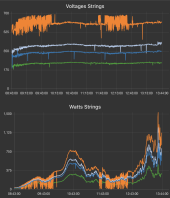I have started monitoring 4 separate strings on 2 Fronius inverters. The system gives no errors and works but one out of 4 strings is behaving strange on low power. It is a 7kW string and this only happens below 350watts of output power, so in lower light, dawn dusk or cloudy overcast.
That string drops power intermittently and i see voltage fluctuations from 520V to 680V, well within spec of the inverter but something is off. This never happens at higher power levels, where is is most of the time.
I switched one inverter for the other and it shows the same behaviour. Cabling looks fine, anyone can advice on how to troubleshoot this ?
Regards

That string drops power intermittently and i see voltage fluctuations from 520V to 680V, well within spec of the inverter but something is off. This never happens at higher power levels, where is is most of the time.
I switched one inverter for the other and it shows the same behaviour. Cabling looks fine, anyone can advice on how to troubleshoot this ?
Regards



